Contents
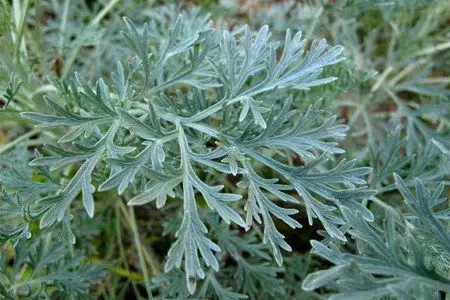
Wormwood belongs to the Compositae family. The plant has a short, branched, lignified root. It grows up to two meters high. In the first year of life, adnexal buds form on the basal neck, the second year is marked by the appearance of shoots that bloom and bear fruit a year later. Artemisia stems are erect, multi-branched in the upper part, silvery-grayish, pubescent. Wormwood herb has a strong spicy smell and bitter taste.
The leaves of the plant at the base are on long petioles, with two or three divisions. The middle of the stem is characterized by leaves on short petioles – bipinnate, separate, sessile and pinnatipartite. Leaflets trifoliate, simple, entire, lanceolate above. In July-August, basket flowers appear – tubular, yellow, small in size, spherical in shape, collected in dense panicle inflorescences. From August to September, seeds ripen in oblong, wedge-shaped, finely furrowed achenes-fruits.
One plant can produce up to 100 seeds, this is its main method of reproduction. Wormwood grass is distributed throughout the European part of the Commonwealth countries. It can be seen in the Caucasus, in Western Siberia. Kazakhstan and Central Asia are also considered the birthplace of wormwood. It grows in empty, abandoned areas, chooses roadsides, forest edges. Medicinal raw materials are harvested during the flowering period, cutting off only the leafy tops.
It is important to collect grass on time, as being late leads to the fact that when drying, the grass becomes dark and the baskets crumble. Dry the plant in attics or in the shade, laying it out in a thin layer and turning it over from time to time. Properly dried wormwood has a fragrant, spicy smell and a spicy-bitter taste.
9 Scientifically Proven Medicinal Properties of Wormwood
1 Eases joint pain
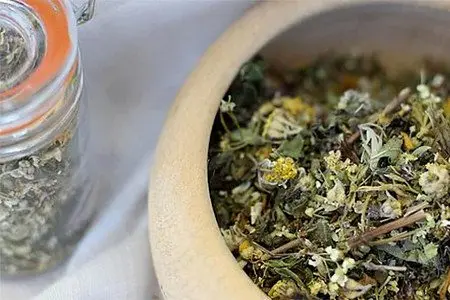
The ability of wormwood to relieve pain and reduce inflammation has been known since ancient China. Experimentally, it was possible to find out that wormwood relieves pain in osteoarthritis – a joint disease accompanied by inflammation. [1] , [2] .
The study involved 90 adult patients diagnosed with osteoarthritis of the knee. For 4 weeks, each of them smears the knee area with an ointment with 3% wormwood – three times a day. All participants noted an improvement in the physical functions of the joints [3] .
But before starting treatment with wormwood, it is important to remember that it is categorically not recommended to touch especially important plants on the peel itself. The fact is that the high activity of wormwood activity can cause serious burns. [4] .
2 Fights parasites
Scientists have found that wormwood has anti-inflammatory properties due to thujone, which is contained in it in large quantities. [5] .
Several animal studies have shown that mugwort fights off tapeworms and other parasites. [6] , [7] .
According to statistics, in the United States, the most common helminthic invasion is pinworms. The eggs of these parasites are passed from person to person. Parasites that primarily affect the intestines include nematodes or roundworms. Tape or long flatworms pose a danger to the health and life of humans and animals.
In 2018, the Journal of Helminthology published the results of a study on animals, which confirmed that wormwood can cause changes in the structure of worms that are incompatible with life, lead to paralysis, and kill some species. [8].
Swedish veterinarians have established that for the treatment of parasitic infestations, farm animals should be given a combined anthelmintic collection of wormwood, chicory and tansy. [9].
3 Has an antioxidant effect
Thujone is considered the most famous substance characteristic of wormwood. However, it contains another important compound – chamazulene, which has pronounced antioxidant properties. The maximum concentration of chamazulene is fixed in essential oils, which are synthesized by wormwood before flowering. [10].
Research results confirm that chamazulene, by realizing an antioxidant effect, helps to cope with oxidative stress caused by free radicals. Scientists link chronic oxidative stress to the development of cardiovascular diseases, cancer, Alzheimer’s disease and other conditions dangerous to the body. [11], [12], [13].
4 Reduces inflammation
Artemisinin, a phytocompound found in large quantities in wormwood, has an anti-inflammatory effect. The use of preparations based on wormwood helps to suppress the inflammation characteristic of long-term chronic diseases.
In the course of laboratory experiments, it was possible to establish that artemisinin suppresses cytokines. Increased synthesis of this type of protein is an immune response to an inflammatory process. [14].
5 Cures malaria
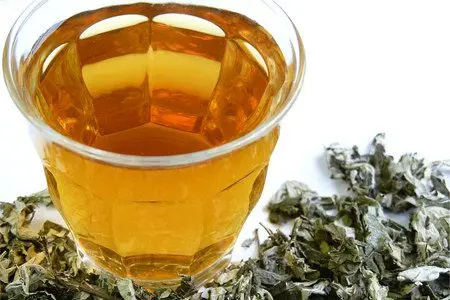
Malaria rightly refers to dangerous infectious diseases. The causative agent is a parasite carried by an infected mosquito during a bite. As a result, the causative agent of malaria enters the bloodstream, infects red blood cells. From the sweet wormwood (lat. Artemisia annua), it was possible to isolate artemisinin in the form of an extract, which became the most powerful herbal remedy that can cure malaria.
To date, artemisinin remains the most effective antimalarial drug, which quickly cleanses the blood of patients from parasites. WHO recommends including artemisinin in combination treatment of uncomplicated Plasmodium falciparum malaria [15].
During the experiments, it was possible to establish that artemisinin reacts with iron, which is concentrated in large quantities inside the parasite. The result is the formation of free radicals that destroy the cell membranes of the causative agent of malaria.
6 Helps fight cancer
One of the latest studies has shown that wormwood can be considered as a natural anticancer therapy option. The fact is that artemisinin has an effect similar to antimalarial on the altered cells in breast cancer.
Malignant tumors intensively absorb iron, which is necessary for the division of altered cells. In 2012, scientists conducted an experiment with breast cancer cells and healthy breast cells. Pre-normal cells were treated to increase the iron content. At the second stage of the study, all cells were treated with an aqueous solution of artemisinin, an extract of wormwood [16].
The results were more than impressive. Healthy cells were not changed, and almost all tumor cells died within 16 hours. Several of the normal cells died, which did not affect the purity of the experiment.
Bioengineer Henry Lai explains this stunning effect by the fact that breast cancer cells contain an average of 10-15 more receptors than healthy ones. Thus, malignant cells absorb iron more easily and faster and are more vulnerable to artemisinin activity.
7 Treats Crohn’s disease
German scientists organized a double-blind study involving 40 people suffering from Crohn’s disease and taking a constant daily dose of steroid drugs. The experimental group took the herbal mixture with wormwood 500 mg three times a day. The control group took a placebo.
The established therapeutic dose of steroids was maintained until the 2nd week. From the 2nd week, the dose of drugs began to be gradually reduced. By the start of week 10, all participants had stopped taking steroids.
The control analysis showed that in 90% of the participants in the experimental sample treated with wormwood, against the background of a decrease in the dose of steroids, there was an improvement in well-being and relief of the symptoms of Crohn’s disease. After 8 weeks of taking mugwort, 65% of the participants had an almost complete remission of the disease. No similar results were observed in the placebo group. It is noteworthy that remission continued throughout the entire follow-up period of 20 weeks. None of the subjects needed to resume steroid therapy. [17].
The results showed that mugwort does more than just ameliorate Crohn’s disease. With its help, you can significantly reduce the need for steroids, improve the quality of life and mood of patients. None of the drugs traditionally used for Crohn’s disease have similar effects.
8 Suppresses bacterial and fungal flora

The Journal of Agricultural and Food Chemistry published data confirming the antibacterial and antifungal activity of wormwood oil. Studies have shown that wormwood essential oils inhibit the growth of several strains of bacteria, including Salmonella, E. coli [18].
E. coli is a dangerous bacterium that can affect various organs and systems. In most cases, it causes severe dyspeptic disorders, diarrhea, but can cause pneumonia, urinary tract infection.
For example, in the United States, about a million diseases associated with foodborne infections are recorded annually. Of the total number of patients, about 19 thousand people are hospitalized, and about 380 die.
The antifungal properties of wormwood have been proven by several studies. For example, during one of them it was possible to establish that the essential oil from the aerial parts of Artemisia absinthium inhibits the growth of 11 species of fungi. In parallel, powerful antioxidant qualities of the studied plant type were recorded. [19].
The results of another study were published in Planta Medica. It turned out that the essential oil of wormwood inhibits the growth of fungi of the genus Candida. This group includes yeast fungi that cause damage to the mucous membranes of the mouth, intestines, vagina, and skin. [20].
9 Treats SIBO
SIBO or SIBO – bacterial overgrowth syndrome is characterized by a whole range of unpleasant symptoms of damage to the small intestine (nausea, abdominal pain, flatulence, problems with appetite and eating behavior). Several studies have confirmed that herbal preparations, such as wormwood capsules or tea, inhibit the spread of bacteria in the gastrointestinal tract and cope with the unpleasant symptoms of SIBO.
Traditional treatment for SIBO involves the administration of oral antibiotics. In one study, 104 patients diagnosed with SIBO were divided into two groups. Participants in one of them took high doses of rifaximin. The second group took an antimicrobial herbal mixture that included wormwood, thyme and berberine extracts, and oregano oil. It is known that these herbs have antimicrobial activity against pathogenic flora that causes SIBO.
After four weeks, 46% of the participants who took the herbal mixture noted no specific symptoms of the disease. Among those who took rifaximin, a similar effect was observed in 34% of participants [21].
In the rifaximin group, all participants experienced some degree of side effects in the form of anaphylaxis, urticaria, diarrhea, and C. difficile colitis. One case of diarrhea was recorded in the herb group. Thus, the researchers concluded that the use of herbs in SIBO has an effect that is not inferior to rifaximin or triple antibiotic therapy, which is prescribed for resistance to rifaximin.
The chemical composition of wormwood
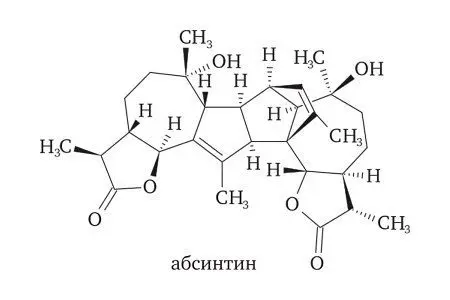
The beneficial properties of wormwood are due to active substances – absinthine, anabsinthine, flavonoids, thujone, pinene, cadinene, bisabolone, chamazulenogen, selinene. Phytoncides, alkaloids, capillin, ascorbic acid, provitamin A were found in the leaves. The plant is rich in malic, succinic acids, tannins, saponins, and carotene.
Galenic substances of the herb stimulate the reflex function of the pancreas, gallbladder, increasing the separation of bile and thereby improving digestion. Terpenoid compounds have anti-inflammatory and cardiostimulatory effects. Wormwood essential oil excites and normalizes the work of the central nervous system. The herb is known for its bactericidal and fungicidal properties due to its unsaturated hydrocarbons.
The use of wormwood
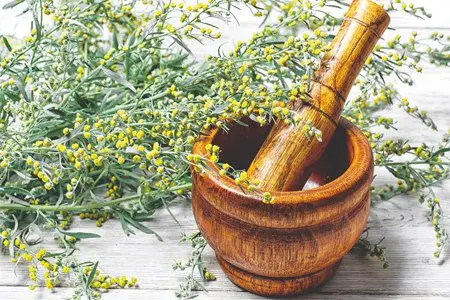
The aerial part of the wormwood herb is used for the preparation of infusions, tinctures, extracts. The bitterness of the plant stimulates the appetite and improves digestion. Wormwood acts as an antispasmodic and anti-inflammatory agent. It has a beneficial effect on the treatment of bronchial asthma, rheumatism. Eczema and burns are perfectly treated with wormwood. Means from the plant are recommended for gastritis, peptic ulcer of the stomach and duodenum. They effectively help with enterocolitis, diseases of the liver and kidneys.
Folk healers advise using infusions and decoctions of wormwood for ascariasis, insomnia. Good results are observed in the treatment of obesity, flatulence, migraine. Using wormwood in complex therapy with other drugs, you can cure pulmonary tuberculosis, hypertension, fever, edema, hemorrhoids. Useful wormwood with an unpleasant smell from the oral cavity, neurasthenia, gout, paralysis, epilepsy.
Frequent fainting, heartburn and cholera are also cured faster with the help of wormwood. In the form of compresses and lotions, infusions and decoctions of herbs relieve pain from inflammation of the joints, bruises, and various eye diseases. Burns, fistulas, ulcers are treated with ointments prepared on the basis of wormwood. The plant is often used in the treatment of headaches, convulsions and paralysis.
Wormwood ointment: it will require 10 g of a thick extract of wormwood, 100 g of vegetable oil or lard.
Wormwood Powder: the grass should be ground into powder and taken 0,5 teaspoon 5-6 times a day after meals, gradually reducing the number of doses to three times a day, during the week. Wormwood powder works more effectively than wormwood infusion.
Artemisia juice: it is pressed before flowering from leaves and branches and taken 1 tablespoon of juice with honey 3 times a day before meals.
[Video] Folk father SHELTER OF ANGELS – how to brew wormwood (biotic method):









